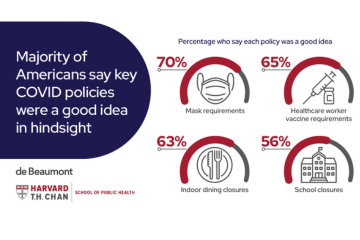
Research shows that a civically engaged community is a healthy community—one that withstands economic downturns, has lower unemployment rates, and enjoys greater social cohesion, among other benefits. Voting is one aspect of civic participation, with significant implications for health: People who vote are represented in policy decisions that influence population-level health outcomes. However, individuals and communities that experience the greatest health inequities often face significant barriers to voter participation, excluding their voices from critical policymaking.
With voting intrinsically linked to people’s health and well-being, health departments have a responsibility to champion voting policies that increase access for all community members. To achieve health equity, we must be proponents of an inclusive democracy. Encouraging civic and voter participation is not inherently partisan as long as the focus is on full participation, without dictating what that participation looks like.
Public health agencies can use their resources and relationships to foster communities in which voting is accessible, easily understood, and part of a larger culture of civic engagement. The following recommendations provide opportunities for health departments to be nonpartisan advocates for voting and advance health equity in the process:
Use Existing Touchpoints for Education and Awareness
Health department employees regularly interact with a wide swath of their communities, many of whom are blocked from voting due to structural inequities rooted in racism, classism, ableism, and other forms of oppression. The same people also encounter more logistical hurdles to voting, such as obtaining government-issued identification; transportation to polling places; accessible voting locations, materials, and assistance; and the ability to take time off. Health departments cannot remove all the systemic barriers to voting, but they are well suited to reach those who have been left out.
Many staff have public-facing roles that allow them to integrate conversations about voting into their regular work. Community health workers can talk to people about voter registration and point them to further resources during home visits, for example. Local health events such as vaccination clinics offer another opportunity to ask whether attendees are registered to vote. Even community events unrelated to health are fitting venues to educate eligible voters and encourage participation. Sponsoring a booth at a local festival or fair to share information on voting is an easy way for health department staff to connect with people where they are.
Within health departments, staff can include voting information on the agency’s Web site and social media channels and share resources on the voting process via e-newsletters. Health departments can also distribute voter education and registration materials in busy areas, such as waiting rooms, where people are already filling out forms.
Bring Voting Into Health Assessments
Incorporating civic and voter participation into community health needs assessments and other planning processes makes the connection between voting and health clear. For example, the Health & Democracy Index, developed by Healthy Democracy Healthy People, compares key public health indicators and voter participation with voting access across the United States. This analysis highlights the relationship between ease of voting and health outcomes and helps make the case for pursuing equitable voting policies.
Civic participation is increasingly being recognized as a data-driven metric for population health outcomes. For example, Healthy People 2030 established “Increasing the proportion of voting-age citizens who vote” as a core objective. Similarly, both voter registration and voter turnout initiatives are among the scientifically supported strategies for improving health outcomes in the County Health Rankings & Roadmaps (CHRR) program. Public health agency leaders can point to these trusted sources when using voting-related measures in their own community health assessments and plans, helping them tell a story and build public will for action.
Collaborate With Local Partners Championing Voting Rights and Access
The growing awareness of the relationship between voter participation and health outcomes paired with ongoing threats to inclusive voter access serves as an urgent call to action. As advocacy for voting rights becomes more urgent, grassroots organizations dedicated to voting rights are seeking cross-sector allies. Public health agencies can get involved with these groups’ nonpartisan efforts to realize equitable voter participation and representation. Collaborating with these organizations allows public health agencies to share resources and expertise and helps build mutually beneficial relationships and credibility with community members.
Health departments can work with community-based organizations such as their local League of Women Voters chapter to ensure that their own efforts are aligned with best practices, including making information about voting accessible to all community members. Another advantage of partnership for health departments is the ability to use existing resources for community engagement. Nonpartisan voting organizations can share their resources such as voting literature and social media tool kits. Their staff or volunteers may also have the capacity to partner with health department staff on webinars, tabling at community events, and other activities to boost voting engagement.
Make an Organizational Commitment to Vote
Encouraging community members to vote is more meaningful when public health agencies lead by example. Making an organization-wide commitment to support voting among a health department’s staff, members, and other partners shows community members that its public health workforce recognizes voting as essential for all. Health department leadership can invite employees and others to sign a voluntary voting pledge and follow up with a voting plan to ensure that they are informed, confident, and prepared. This voluntary commitment can also be expanded to reach community members, underscoring voting rights as a public health value. For inspiration, see the We Will Vote Organization Statement of Commitment 2024 developed in partnership with Healthy Democracy Healthy People, Vot-ER, and the Civic Health Alliance.
Additional Resources
The recommendations in this column are several ways that health departments can help their community members exercise their right to vote. To learn more about the relationship between voting and health and how your organization can support local voting efforts, see additional resources from Healthy Democracy Healthy People.




